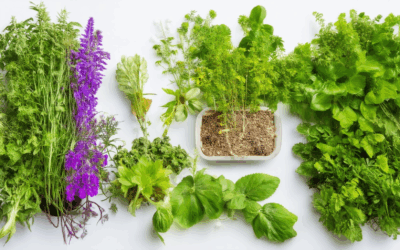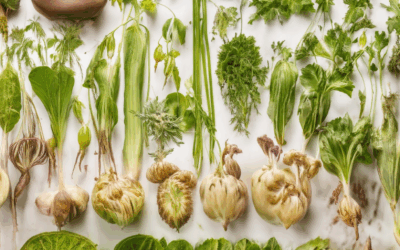Sustainable plant propagation has emerged as a cornerstone of modern gardening and agriculture, offering eco-conscious growers a way to cultivate thriving, self-sustaining ecosystems. By focusing on techniques that mimic natural processes, enthusiasts can propagate plants in ways that are both environmentally friendly and economically viable. This approach not only reduces reliance on external inputs but also fosters a deeper connection between growers and the plants they nurture. From permaculture methods to natural propagation techniques, the possibilities for sustainable plant propagation are vast, each offering unique benefits for both the environment and the grower. Whether you’re looking to establish a small urban garden or scale up to larger agricultural projects, understanding the principles of sustainable propagation is essential for creating resilient and productive growing spaces.
Key Takeaways
– Master Sustainable Plant Propagation: Utilize methods like layering, division, rooting, grafting, and cutting to efficiently propagate plants, enhancing your permaculture garden’s sustainability.
– Natural Propagation Techniques: Employ root division, stem cuttings, leaf propagation, and bromide division to grow your plants naturally and sustainably.
– Permaculture Fundamentals: Design a self-sustaining ecosystem by understanding succession, composting, and attracting pollinators.
– Efficient Garden Setup: Choose the right location, prepare soil, build raised beds, install watering systems, and maintain regular care for a thriving permaculture garden.
– Sustainable Practices: Use high-quality compost, ensure proper drainage, and focus on propagation to support biodiversity and eco-friendly growth.
How is Propagation Sustainable?
Propagation plays a vital role in sustainable farming practices, offering several benefits that contribute to environmental health and agricultural resilience. Here’s how propagation supports sustainability:
- Genetic Diversity : By propagating plants from existing stock, farmers can maintain heirloom varieties and genetic diversity. This reduces reliance on synthetic chemicals and mono-cropping, which can harm ecosystems and soil health.
- Resource Efficiency : Propagation methods, such as cloning or using cuttings, often require fewer resources like water and fertilizers compared to traditional planting methods. This makes farming more efficient and less impactful on the environment.
- Economic Benefits : Heirloom seeds propagated from local varieties can be sold at premium prices, supporting local economies and providing diverse options for consumers. This encourages biodiversity and cultural preservation.
- Reduced Chemical Use : Propagated plants are often more robust and resistant to pests and diseases, reducing the need for chemical pesticides and herbicides. This promotes healthier soil and safer food production.
Propagation is a cornerstone of sustainable farming, helping to preserve biodiversity, enhance resource efficiency, and promote eco-friendly practices. By embracing propagation, farmers can build a more sustainable and resilient agricultural system for future generations.
Learn more about the benefits of propagation and how it contributes to sustainable farming practices.
Why is it Illegal to Propagate Plants?
Propagation of plants, particularly in commercial contexts, is often regulated due to several legal and ethical considerations:
- Intellectual Property Rights : Many plant varieties are protected under intellectual property laws, specifically through patents. Breeding a unique hybrid or cultivar requires significant investment and expertise, and propagating such plants without permission can infringe on these rights.
- Biosecurity Regulations : To prevent the spread of invasive species and pests, governments often impose restrictions on the propagation and sale of certain plants. Unauthorized propagation can introduce harmful organisms to ecosystems.
- Plant Breeders’ Rights : Laws like the Plant Breeders’ Rights Act grant breeders exclusive rights over their creations for a set period. Propagating without authorization can violate these rights and result in legal action.
- Market Competition : Unauthorized propagation can undermine the financial viability of legitimate breeders and sellers, affecting fair trade practices.
- Digital Tracking : Advanced systems may track propagated plants to ensure authenticity, with penalties for those who circumvent these measures.
Examples of enforcement include legal actions against those replicating patented varieties, mirroring the approach taken against copyright infringement. Thus, propagation is restricted not just by law but also by the need to support innovation and maintain ecological health.
What 5 Methods Could Be Used to Propagate Plants?
Here are five effective methods for propagating plants:
- Stem Cutting: Take a portion of the stem from a healthy plant and remove the leaves. Dip the cut end in a rooting hormone and place it in moist soil or a growing medium. Keep it in a warm, bright location until roots develop.
- Root Division: Divide the root system of a healthy plant into smaller sections, ensuring each has its own root and growth bud. Plant each section separately in well-draining soil.
- Layering: Create a new branch by pinching away non-flowering shoots close to the main stem. Cover these shoots with soil to encourage root development, then separate them once rooted and transplant them.
- Budding: Graft a part of one plant onto another to create a new individual plant. This method works well with fruit trees and shrubs.
- Grafting: Join pieces of two different plants together, typically at a bud. This technique allows the growth of a new plant that combines the traits of both species.
By using these methods, you can effectively propagate plants and expand your garden or farm. Explore more techniques and resources on Old Seed to learn about sustainable gardening methods.
How to Propagate Plants in Permaculture
In permaculture, plant propagation is a key part of maintaining healthy ecosystems and saving resources. Here are some effective methods to propagate plants:
- Layering: This method involves bending a plant’s stem to the ground and covering it with soil. The plant will grow roots from the stem, creating a new plant. This works well for woody plants like fruit trees.
- Division: Divide established plants into smaller sections, ensuring each has a healthy root system. This is ideal for herbaceous perennials and rhizomes.
- Rooting: Cut a piece of the plant and place it in water or damp soil to encourage root growth. This is a simple way to propagate plants like cuttings.
- Grafting: Join two plants together at a joint to form one composite plant. This is useful for creating multi-stemmed shrubs or trees.
- Budding: Graft a bud from one plant onto another to create a new plant. This method is often used for ornamental plants.
- Budding Off: Similar to budding, but the grafted section is detached and grown independently. This is useful for propagating desirable traits.
- Cutting: Take a portion of the plant and remove it just below the node. Place it in soil or water to grow a new plant. This is a quick method for many species.
For best results, propagate during the dormant season or early spring. Use high-quality compost and ensure proper drainage to support healthy root development. By propagating plants, you can expand your permaculture garden while maintaining biodiversity and sustainability.
Learn more about advanced propagation techniques and tools on our plant propagation guide .
How to Propagate Plants Naturally
Propagating plants is a fantastic way to grow your own plants for free and expand your garden or indoor space. Here are some effective methods to propagate plants naturally:
1. Root Division
Gently divide the roots of healthy plants to create new individuals. This method works best for plants with fibrous roots, such as roses, dahlias, and sweet potatoes.
- Use a shovel or your hands to dig up the plant.
- Separate the roots carefully, ensuring each piece has at least one growth node.
- Plant the divided roots in rich soil and water regularly until they establish.
Learn more about root division techniques .
2. Stem Cuttings
Take stem segments from healthy plants and root them in a potting mix or water. This method works for many herbaceous plants and shrubs.
- Choose stems that are 4-6 inches long and remove the lowest leaves.
- Place the stem in a container with well-draining soil or water.
- Keep the environment warm and well-lit to encourage rooting.
Discover stem cutting propagation secrets .
3. Leaf Propagation
Some plants can regrow from single leaves, though this method is less common. Try it with plants like the jade plant or begonias.
- Remove a healthy leaf from the plant.
- Place it on a moist medium, such as sphagnum moss.
- Wait for new growth to appear before planting it in soil.
Explore leaf propagation techniques .
4. Division of Bromides
Bromide plants, like pineapple cacti, often produce “pups” that can be separated and grown into new plants.
- Look for established bromide plants with offsets attached.
- Carefully separate the pups from the parent plant.
- Transplant them into individual pots and water regularly.
5. Layering
A lesser-known method, layering involves bending a plant’s stem to create a “layer” that can develop into a new plant over time.
- Bend a flexible stem near the base and bury it partially in the soil.
- Keep the area moist and wait for roots to form.
- Eventually, a new plant will grow from the layered stem.
Understand layering propagation .
By using these natural propagation methods, you can easily multiply your favorite plants and enjoy fresh greens, flowers, and vegetables year-round. Experiment with different techniques to find what works best for your garden!
How to Start a Permaculture Garden from Scratch
Starting a permaculture garden is an exciting journey that allows you to create a sustainable and eco-friendly space. Below is a step-by-step guide to help you begin:
1. Understand Permaculture Basics
Permaculture focuses on designing self-sustaining ecosystems that mimic natural patterns. Key principles include:
- Succession : Plants grow in layers, supporting each other over time.
- Composting : Use organic waste to enrich your soil.
- Pollinator Attraction : Plant flowers and herbs to attract beneficial insects and pollinators.
2. Choose the Right Location
Select a sunny spot with easy access to water. Avoid low-lying areas prone to frost.
3. Assess and Prepare the Soil
Test your soil for pH levels and nutrients. Improve it with compost, manure, or worm castings. Consider raised beds for uneven ground.
4. Design Your Layout
Plan your garden using permaculture patterns like spiral or guilds. Research plant guilds suited to your climate and needs.
5. Build Raised Beds
Construct raised beds using wood or other materials. Follow online tutorials for proper construction and sizing.
6. Install Watering Systems
Set up drip irrigation for efficient watering. Consider rainwater harvesting systems for added sustainability.
7. Compost Effectively
Layer kitchen scraps with brown materials in your compost bin. Monitor for heat and turn regularly to aerate.
8. Establish Plants
Plant seeds or transplants in mid-spring. Apply mulch to retain moisture and suppress weeds.
9. Maintain Regularly
Care for each plant and monitor for pests. Use natural controls like companion plants or beneficial insects.
10. Harvest Properly
Know when to harvest each plant and store crops like root vegetables and fruits correctly.
Sustainability Tips
Consider renewable energy sources for tools and reduce plastic use in your garden practices.
By following these steps, you’ll create a thriving permaculture garden that benefits the environment and supports sustainable living. Happy gardening!








0 Comments